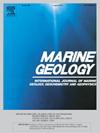Impacts of climate change on the morphodynamics of embayed beaches along the Central West Coast of India
IF 2.2
3区 地球科学
Q2 GEOSCIENCES, MULTIDISCIPLINARY
引用次数: 0
Abstract
This study investigates the morphodynamics and climatic influences on twenty-seven embayed beaches along the central west coast of India utilizing a comprehensive framework that combines in-situ field observations and remote sensing. These coastal features were classified for the first time using an embayment morphometric parameter (γe) derived from the embayment area (Ae) and indentation (a). This method enabled the categorization of the embayments into three distinct classes - Class 1 (open/exposed), Class 2 (semi-exposed), and Class 3 (Semi-closed/sheltered). Field measurements of beach profiles were conducted for sixteen accessible embayed beaches, focusing on seasonal and annual volumetric changes. The results showed a significant reduction in beach volume from February to September, likely caused by strong monsoonal waves, with partial recovery observed from September to February. To study long-term changes, we analyzed changes in area over three decades (1990–2023) using satellite images. This analysis revealed a maximum erosion of 81.72 m at Mirya and maximum accretion of 62.5 m at Undi, while Net Shoreline Movement (NSM) trends reveal that eight embayments, including Palshet, Hedavi, and Vengurla, are undergoing critical shoreline retreat. Various climate factors, including rising sea levels, increased frequency of cyclones, wave power, and swells, were analyzed to track the causes. The results indicated an increase in regional sea levels, cyclone activity, and wave power, which corresponded with the observed erosion patterns along the central west coast of India. Anthropogenic impacts were also noted,the construction of breakwaters and jetties has caused significant alterations. This study highlights, how human interventions can disrupt natural coastal processes. A key finding of the study is that embayments, which appear stable on seasonal and annual timescales, are dynamic and unstable over the decadal scale.
气候变化对印度中西海岸海湾海滩形态动力学的影响
本研究利用现场观测和遥感相结合的综合框架,调查了印度中部西海岸27个海湾海滩的形态动力学和气候影响。这些海岸特征首次使用从河口区域(Ae)和凹陷(a)得到的河口形态计量参数(γ - e)进行分类。这种方法可以将炮口分为三个不同的类别- 1类(开放/暴露),2类(半暴露)和3类(半封闭/遮蔽)。我们实地测量了16个可通达的海湾泳滩的海滩剖面,重点是季节性和年度体积变化。结果显示,2月至9月期间,泳滩面积明显减少,可能是受强烈的季候风浪影响,但在9月至2月期间,泳滩面积有部分恢复。为了研究长期变化,我们利用卫星图像分析了三十年(1990-2023)的面积变化。该分析显示,Mirya的最大侵蚀为81.72 m, Undi的最大增加为62.5 m,而净海岸线运动(NSM)趋势显示,包括Palshet, Hedavi和Vengurla在内的8个河口正在经历关键的海岸线退缩。研究人员分析了各种气候因素,包括海平面上升、飓风频率增加、波浪能和涨潮,以追踪原因。结果表明,区域海平面、气旋活动和波浪力增加,这与观测到的印度中部西海岸侵蚀模式相一致。人为的影响也被注意到,防波堤和码头的建设造成了重大的变化。这项研究强调了人类干预是如何破坏自然海岸过程的。该研究的一个关键发现是,在季节和年度时间尺度上看起来稳定的河口,在十年尺度上是动态的和不稳定的。
本文章由计算机程序翻译,如有差异,请以英文原文为准。
求助全文
约1分钟内获得全文
求助全文
来源期刊

Marine Geology
地学-地球科学综合
CiteScore
6.10
自引率
6.90%
发文量
175
审稿时长
21.9 weeks
期刊介绍:
Marine Geology is the premier international journal on marine geological processes in the broadest sense. We seek papers that are comprehensive, interdisciplinary and synthetic that will be lasting contributions to the field. Although most papers are based on regional studies, they must demonstrate new findings of international significance. We accept papers on subjects as diverse as seafloor hydrothermal systems, beach dynamics, early diagenesis, microbiological studies in sediments, palaeoclimate studies and geophysical studies of the seabed. We encourage papers that address emerging new fields, for example the influence of anthropogenic processes on coastal/marine geology and coastal/marine geoarchaeology. We insist that the papers are concerned with the marine realm and that they deal with geology: with rocks, sediments, and physical and chemical processes affecting them. Papers should address scientific hypotheses: highly descriptive data compilations or papers that deal only with marine management and risk assessment should be submitted to other journals. Papers on laboratory or modelling studies must demonstrate direct relevance to marine processes or deposits. The primary criteria for acceptance of papers is that the science is of high quality, novel, significant, and of broad international interest.
 求助内容:
求助内容: 应助结果提醒方式:
应助结果提醒方式:


